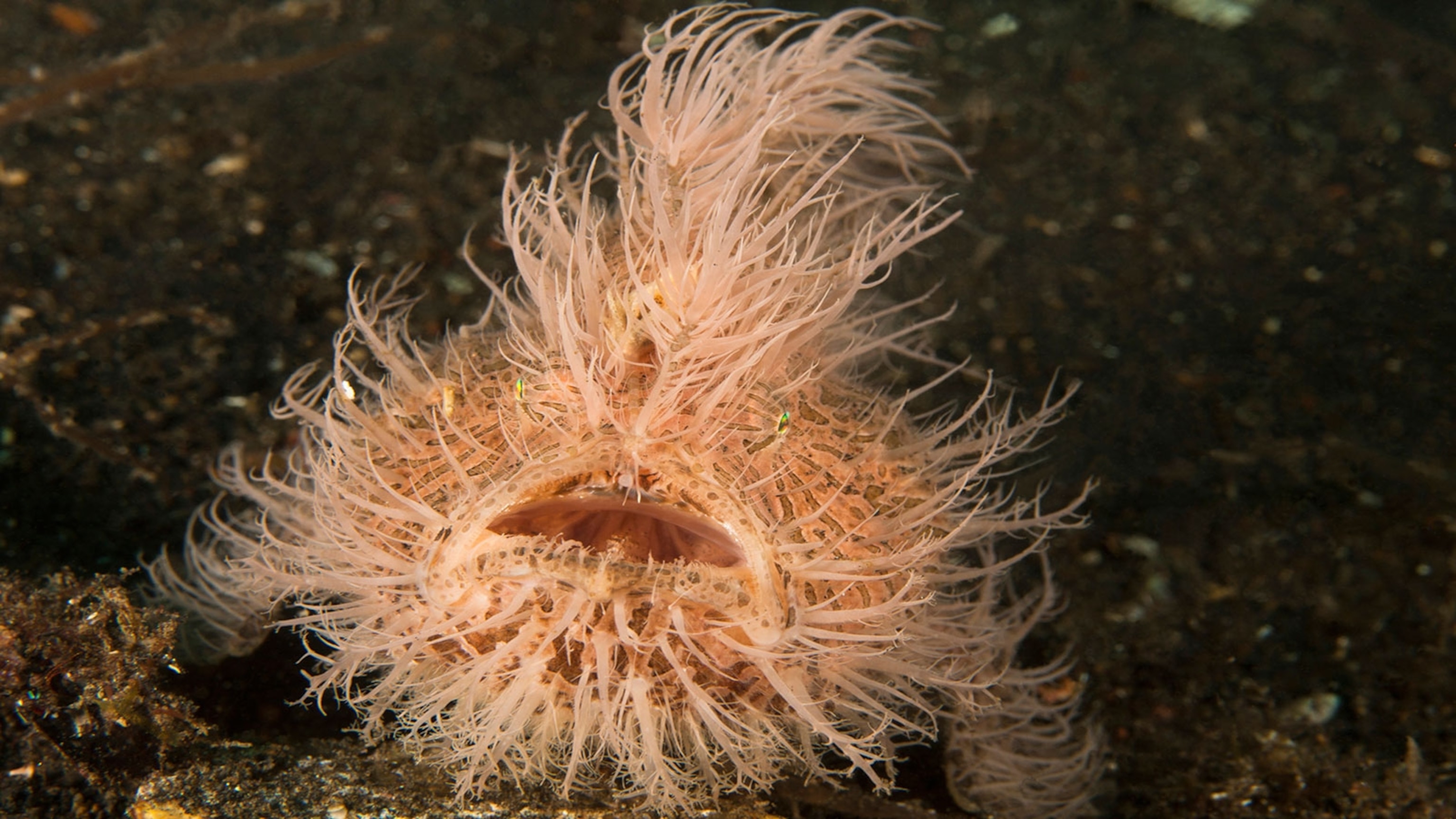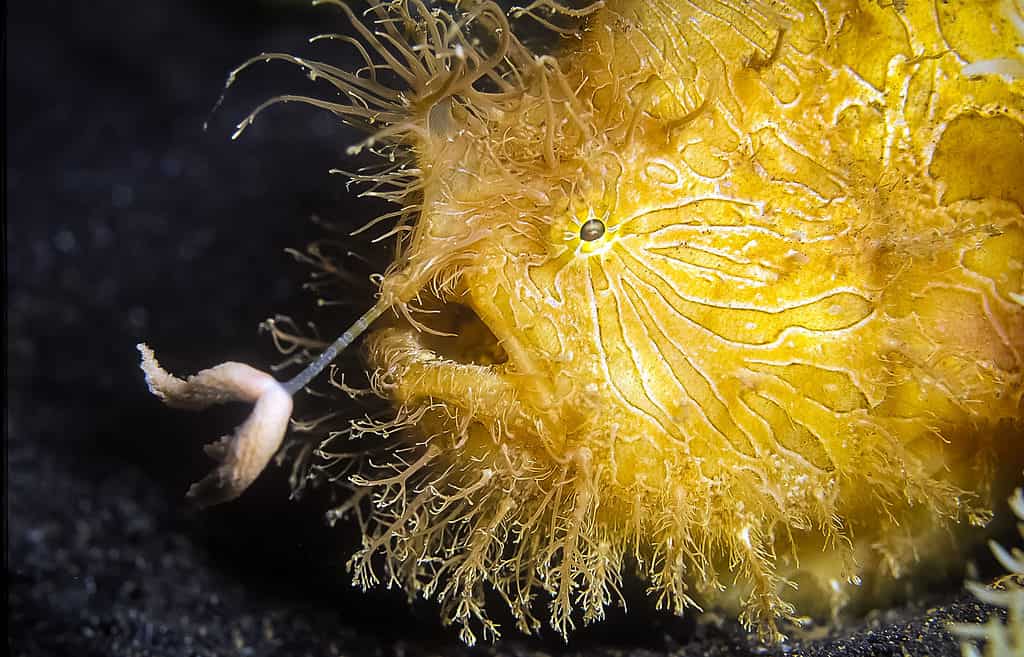The blue hairy frogfish, scientifically named Antennarius striatus, is one of the ocean’s most unusual and fascinating creatures.
Known for its distinctive hair-like skin filaments, this peculiar fish sports a range of colors, including blue, yellow, brown, and green, allowing it to blend effortlessly into its surroundings.
From its camouflage abilities to its specialized hunting techniques, the blue hairy frogfish exemplifies nature’s creative adaptation. Let’s dive into what makes this intriguing species such a captivating subject in marine biology.
A Unique Appearance: Hair-Like Filaments and Vibrant Colors
The blue hairy frogfish’s standout feature is its unusual skin, adorned with filament-like structures resembling hair. These “hairs” are not just for show; they serve a dual purpose in both protection and predation.
Camouflage is the frogfish’s primary defense mechanism, and these hair-like projections help break up its shape, allowing it to blend seamlessly into its environment, whether that’s a vibrant coral reef or a patch of rubble on the ocean floor.

Adding to its camouflage, the blue hairy frogfish displays an impressive color range. While “blue” is part of its common name, it can also appear in shades of yellow, brown, and green.
This color variation helps it mimic various marine surroundings, from coral reefs to rocky seabeds. Changing color to adapt to its immediate environment, it can remain concealed from both predators and prey alike.
Habitat: A Preference for Tropical and Subtropical Waters
The blue hairy frogfish typically inhabits tropical and subtropical waters, where warm temperatures and coral reefs provide ideal living conditions. They are commonly found in regions with an abundance of coral and sponges, which offer plenty of cover.

Frequently seen on the seafloor, these fish are adept at hiding amidst coral rubble, debris, or patches of seagrass. Their affinity for the ocean floor suits their hunting style, as their prey is often found in these areas as well.
Ambush Predator: The Art of Deceptive Hunting
What truly sets the blue hairy frogfish apart is its unique hunting technique. Classified as an ambush predator, this fish doesn’t chase down its prey like most fish; instead, it lures unsuspecting animals directly to it.
The frogfish has a specialized structure called an esca, a modified dorsal fin that functions as a bait-like appendage. The esca closely resembles a small worm or shrimp, which are typical prey for other fish.

By moving its esca in a way that mimics the behavior of live prey, the frogfish creates the illusion of a tempting meal, drawing its target closer.
Once the prey is within reach, the blue hairy frogfish strikes with astonishing speed. It has an extensible mouth that can rapidly expand to nearly double its size, enabling it to swallow prey almost instantly.
This lightning-fast reaction leaves its prey little chance to escape. The frogfish’s vacuum-like suction when it opens its mouth allows it to capture prey in less than a millisecond, making it one of the ocean’s most efficient ambush predators.
The “Walking” Fish: A Unique Mode of Locomotion
One of the most curious aspects of the blue hairy frogfish is its unusual way of moving. Unlike most fish that rely on swimming to move through the water, the frogfish has adapted to “walk” along the ocean floor using its pectoral fins.
These fins act like legs, allowing the frogfish to shuffle along the seabed rather than swim. This “walking” behavior is not only practical for an ambush predator but also aligns well with its slow-moving, stealthy lifestyle. Moving close to the ground, it can quietly approach its target without attracting attention, enhancing its effectiveness as a hunter.

This peculiar way of moving, combined with its camouflage abilities, means that the blue hairy frogfish is rarely seen by other sea creatures. It remains inconspicuous both to prey and potential predators, further securing its survival in a competitive environment.
Camouflage as a Survival Strategy
The blue hairy frogfish’s ability to camouflage is not only impressive but vital for its survival. As a relatively slow mover, it lacks the agility to evade predators in open water. Instead, it relies heavily on its color-changing ability and hair-like projections to blend into its surroundings.
When a predator approaches, the frogfish often remains motionless, confident in its disguise. This strategy of “freezing” while camouflaged makes it almost impossible for predators to distinguish it from the surrounding debris or coral.

Beyond protection from predators, camouflage aids in hunting, as the frogfish can conceal itself near potential prey, waiting patiently for an opportune moment to strike.
This dual use of camouflage for both defense and predation makes the blue hairy frogfish a perfect example of nature’s ingenious adaptations.
Life Cycle and Reproduction
Like many other marine species, the blue hairy frogfish has a unique reproductive process. During mating, the female releases thousands of eggs into the water, which are then fertilized by the male.
These eggs form a gelatinous mass that floats near the surface, offering some protection until they hatch. Once the eggs hatch, the larvae begin their lives as plankton, drifting with ocean currents until they develop into juveniles and settle on the ocean floor.
While little is known about the specific lifespan of the blue hairy frogfish, its life cycle, from larva to adult, reflects a typical pattern for many reef-dwelling fish.
Adaptations for a Changing Environment
The adaptability of the blue hairy frogfish extends beyond its camouflage and hunting techniques. Like many reef-dwelling species, it faces environmental threats such as habitat destruction and ocean pollution.
Coral reefs, a primary habitat for the frogfish, are sensitive ecosystems vulnerable to warming waters and acidification. The blue hairy frogfish’s ability to blend into varied environments gives it a certain resilience, but threats to its habitat could impact its populations in the future.

Conservation efforts focused on protecting coral reefs indirectly benefit species like the blue hairy frogfish, helping to preserve the intricate ecosystems on which they rely.
By supporting reef health, conservationists can help maintain the balance in these biodiverse habitats, ensuring the survival of this and many other unique marine species.
The Role of Frogfish in Marine Ecology
Beyond its role as a fascinating creature, the blue hairy frogfish plays an integral role in maintaining marine ecosystem balance.
As a predator, it helps regulate populations of small fish and invertebrates, preventing any one species from becoming overly dominant. In this way, the blue hairy frogfish contributes to the biodiversity of coral reefs and the overall health of the ecosystem.

This fish also serves as a reminder of the delicate balance in nature. Its specialized adaptations highlight the interconnectedness of marine life, where each species, no matter how peculiar, fulfills a vital role.
Conclusion
The blue hairy frogfish stands out not only for its striking appearance but also for the incredible survival strategies it has developed.
From its hair-like filaments and color-changing abilities to its ambush predation and “walking” movement, this fish is a marvel of evolutionary adaptation. Its specialized traits, which allow it to blend into its surroundings and capture prey with efficiency, underscore the diversity and ingenuity of life in the ocean.
As we continue to study and appreciate species like the blue hairy frogfish, we gain a deeper understanding of the intricate ecosystems within our oceans.
Protecting these habitats is essential to ensure that remarkable creatures like the blue hairy frogfish continue to thrive, enriching the underwater world with their unique adaptations and behaviors.








